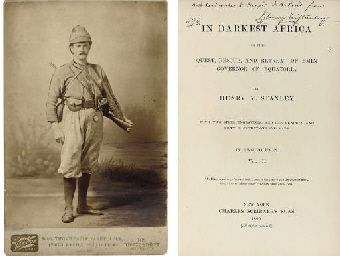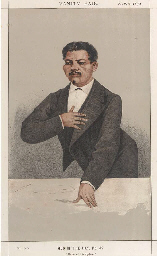HENRY MORTON STANLEY (1841-1904) How I Found Livingstone: Travels, Adventures and Discoveries in Central Africa including an account of four months' residence with Dr. Livingstone . New York: Scribner, Armstrong, 1872. 8° (226 x 143mm.). Wood-engraved frontispiece of Stanley and Kalulu, 27 wood-engraved plates, 5 lithographic maps, 4 folding, one with Stanley's survey route of Lake Tanganika printed in red and green. (The two larger maps cleanly torn and mounted on linen.) Original brown cloth, upper cover and spine with gilt-stamped vignettes (Small tears, gilt somewhat rubbed, spine frayed at head and foot, lower corners bumped, front inner hinges split.). Provenance : presented by Stanley to James Tooley (see below); sold at Sotheby's, 13 November 1929, lot 447, to Bernard Quaritch for £3 10s (collation note signed E.M.S. at end of vol.); thence to the Stanley family. PRESENTATION COPY OF THE FIRST AMERICAN EDITION, with inscription to [James] Tooley on half title reading: 'For the sake of that sweet friendship begun between us at Constantinople in 1870 please accept this book my dear Tooley/from yours sincerely/Henry M. Stanley March 14th 1873.' This copy also contains a tipped-in 1¼ PAGE AUTOGRAPH LETTER FROM STANLEY TO TOOLEY, dated American Consulate General Constantinople March 31 1870, and a head and shoulders carte de viste portrait of Stanley, by Abdullah Fréres, Constantinople inscribed on verso by Stanley "April 7 t h 1870, Sympathetically yours Henry M. Stanley". In the letter, Stanley thanks him for the telegram from Beirut, which proposed a meeting between them at Smyrna. He is unable to leave Constantinople, being 'so overwhelmed with matter for writing ... having just returned from a month's travel in the Crimea and Southern Russia, and for all this I have to render full account in the "Herald."' He therefore suggests that Tooley 'come up to Stamboul after two or three days stay at Smyrna. Our people here are truly gracious to "Herald" men, and as the church of St. Polycarp at Giaour Ismir has but few attractions the delights of true believing Stamboul await you.' If Tooley 'can not come up directly,' Stanley wishes him 'to state the route you have taken from India up here, and give in brief contents of letters sent by you to the "Herald" office since you left Bombay. This I desire to know, because it will govern my route, and I shall be able to avoid rewriting what perhaps may have been so ably written by you ....' (some browning to letter and fragility to folds). When Stanley met James Gordon Bennett editor and proprietor of the New York Herald , in the Grand Hotel, Paris, on 16 October 1869, to be given the instruction to go to central Africa to find Livingstone, he was also given other commissions to fulfil first. These included a visit to Constantinople to '"find out about that trouble between the Khedive and the Sultan. Then,"' Bennett told him, '"let me see -- you might as well visit the Crimea and those old battle grounds. Then go across the Caucasus to the Caspian Sea; I hear there is a Russian expedition bound for Khiva. Thence you may get through Persia to India; you could write an interesting letter from Persepolis. Bagdad will be close on your way to India; suppose you go there and write up something about the Euphrates Valley Railway. Then, when you have come to India, you can go after Livingstone ...."' (Jacob Wassermann, H.M. Stanley Explorer , 1932, pp. 53-54). So, before even beginning his expedition to rescue Livingstone in 1871, Stanley reported on the opening of the Suez Canal, made a journey down the Nile, visited Jerusalem to report on the latest excavations, then journeyed to Constantinople, arriving early in February 1870, going from there to the Caucasus, to Batum, Tiflis, Baku, Resht, Teheran, Shiraz, Bushire and Bombay, before at last reaching his starting point for the Stanley expedition at Zanzibar. This copy of How I found Livingstone , with its emotionally-frank inscriptio
HENRY MORTON STANLEY (1841-1904) How I Found Livingstone: Travels, Adventures and Discoveries in Central Africa including an account of four months' residence with Dr. Livingstone . New York: Scribner, Armstrong, 1872. 8° (226 x 143mm.). Wood-engraved frontispiece of Stanley and Kalulu, 27 wood-engraved plates, 5 lithographic maps, 4 folding, one with Stanley's survey route of Lake Tanganika printed in red and green. (The two larger maps cleanly torn and mounted on linen.) Original brown cloth, upper cover and spine with gilt-stamped vignettes (Small tears, gilt somewhat rubbed, spine frayed at head and foot, lower corners bumped, front inner hinges split.). Provenance : presented by Stanley to James Tooley (see below); sold at Sotheby's, 13 November 1929, lot 447, to Bernard Quaritch for £3 10s (collation note signed E.M.S. at end of vol.); thence to the Stanley family. PRESENTATION COPY OF THE FIRST AMERICAN EDITION, with inscription to [James] Tooley on half title reading: 'For the sake of that sweet friendship begun between us at Constantinople in 1870 please accept this book my dear Tooley/from yours sincerely/Henry M. Stanley March 14th 1873.' This copy also contains a tipped-in 1¼ PAGE AUTOGRAPH LETTER FROM STANLEY TO TOOLEY, dated American Consulate General Constantinople March 31 1870, and a head and shoulders carte de viste portrait of Stanley, by Abdullah Fréres, Constantinople inscribed on verso by Stanley "April 7 t h 1870, Sympathetically yours Henry M. Stanley". In the letter, Stanley thanks him for the telegram from Beirut, which proposed a meeting between them at Smyrna. He is unable to leave Constantinople, being 'so overwhelmed with matter for writing ... having just returned from a month's travel in the Crimea and Southern Russia, and for all this I have to render full account in the "Herald."' He therefore suggests that Tooley 'come up to Stamboul after two or three days stay at Smyrna. Our people here are truly gracious to "Herald" men, and as the church of St. Polycarp at Giaour Ismir has but few attractions the delights of true believing Stamboul await you.' If Tooley 'can not come up directly,' Stanley wishes him 'to state the route you have taken from India up here, and give in brief contents of letters sent by you to the "Herald" office since you left Bombay. This I desire to know, because it will govern my route, and I shall be able to avoid rewriting what perhaps may have been so ably written by you ....' (some browning to letter and fragility to folds). When Stanley met James Gordon Bennett editor and proprietor of the New York Herald , in the Grand Hotel, Paris, on 16 October 1869, to be given the instruction to go to central Africa to find Livingstone, he was also given other commissions to fulfil first. These included a visit to Constantinople to '"find out about that trouble between the Khedive and the Sultan. Then,"' Bennett told him, '"let me see -- you might as well visit the Crimea and those old battle grounds. Then go across the Caucasus to the Caspian Sea; I hear there is a Russian expedition bound for Khiva. Thence you may get through Persia to India; you could write an interesting letter from Persepolis. Bagdad will be close on your way to India; suppose you go there and write up something about the Euphrates Valley Railway. Then, when you have come to India, you can go after Livingstone ...."' (Jacob Wassermann, H.M. Stanley Explorer , 1932, pp. 53-54). So, before even beginning his expedition to rescue Livingstone in 1871, Stanley reported on the opening of the Suez Canal, made a journey down the Nile, visited Jerusalem to report on the latest excavations, then journeyed to Constantinople, arriving early in February 1870, going from there to the Caucasus, to Batum, Tiflis, Baku, Resht, Teheran, Shiraz, Bushire and Bombay, before at last reaching his starting point for the Stanley expedition at Zanzibar. This copy of How I found Livingstone , with its emotionally-frank inscriptio















Try LotSearch and its premium features for 7 days - without any costs!
Be notified automatically about new items in upcoming auctions.
Create an alert